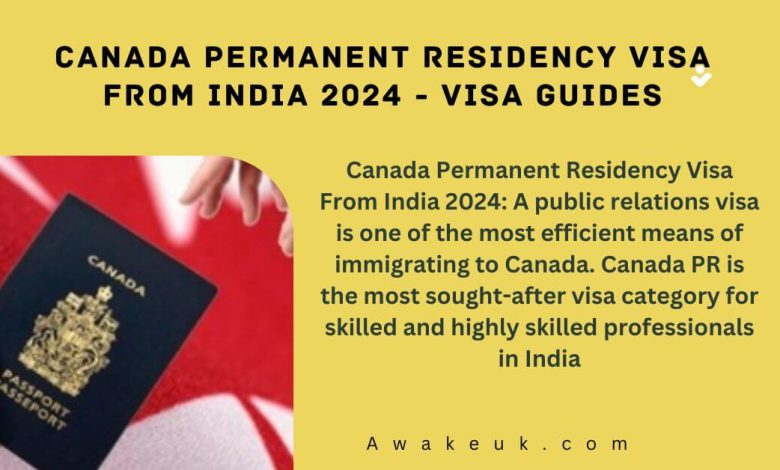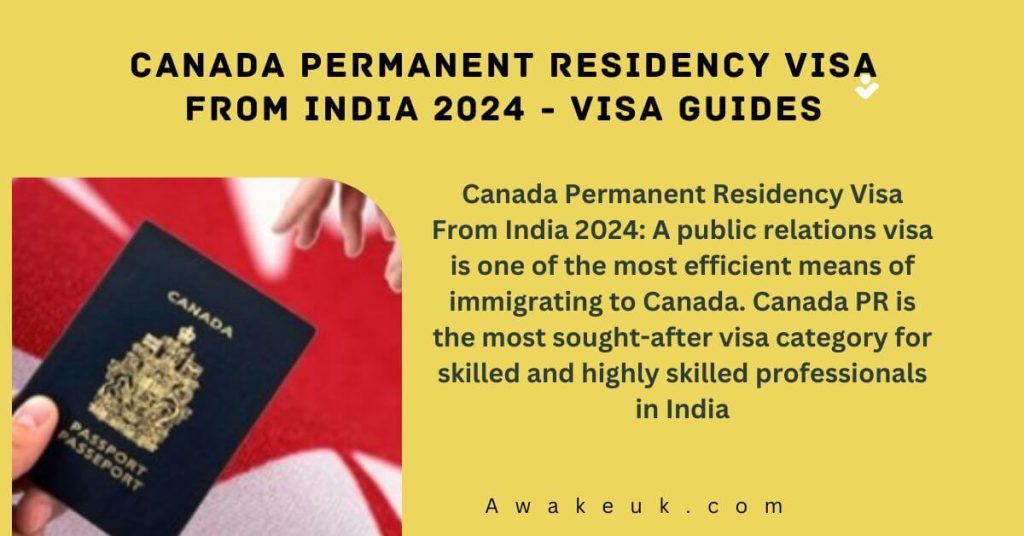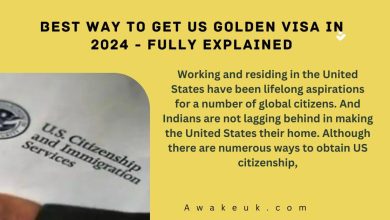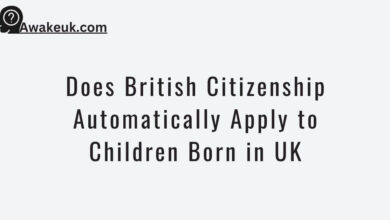Canada Permanent Residency Visa From India 2024 – Visa Guides

A public relations visa is one of the most efficient means of immigrating to Canada. Canada PR is the most sought-after visa category for skilled and highly skilled professionals in India. One of the requirements for obtaining a Permanent Resident Visa in Canada is to apply through a migration program such as Express Access or PNP.
Introduction to Canada’s Permanent Residency Visa
People who have a Permanent Residency Visa (PR Visa) can live, work, and stay in Canada for as long as they want. That’s because this visa has a lot of benefits, like letting you use social services, healthcare, and education, and it also lets you ask for Canadian citizenship in the future.
Canada Public Relations Visa from India
With its flexible immigration policies, autonomous values, multiculturalism, employment opportunities, and even Indian communities, Canada is a popular destination. Consequently, hundreds of Indians use and successfully obtain Canada PR visas from India. One can either undertake the PR process on their own or seek assistance from a licensed migration professional. However, before applying for a Canada Permanent Residency Visa, let’s discuss eligibility and requirements in detail.
What is the Canada Permanent Residency Visa From India?
When discussing the Canada Public Relations (Long-term Local) Visa, one is not referring to a Canadian citizen, such as trainees or international workers staying temporarily in Canada. Foreign nationals who have relocated to Canada are required to apply for a PR visa to take advantage of the country’s benefits. However, there are eligibility and other requirements that must be met by the candidate.
Getting a Canada Permanent Residency Visa From India
There are multiple routes to Canada from India. If you meet the PR requirements, obtaining a Canadian permanent resident visa is straightforward. Observe the procedure outlined below:
In the first month of 2015, the Express Entry Program was introduced as a means to enter Canada from India. Applicants for a Canadian public relations visa are required to protect certain factors through their credentials. Age, education, work experience, and language proficiency are used to calculate the factors. There are three subcategories of this program: the Federal Skilled Workers program, the Federal Proficient Investors program, and the Canadian Experience Class (CEC), from which the applicant may choose the one that best fits his or her situation. The Federal Skilled Workers Program is the most prominent subcategory for moving. The Federal Skilled Trades Program is for experienced professional occupations such as chefs, construction workers, etc., and no instructional certification is required for selection under this classification. The final Canadian Experience Class (CEC) is for candidates who already have Canadian work experience and are transferring through a work permit, etc.
Provincial Candidate Program (PNP): As a way to enter Canada, the Provincial Candidate Program is for candidates from India who wish to obtain permanent residency in Canada and who are selected by a specific district for a shortage occupation. The selected applicants may enter the district that selected them. Remember that each province has its requirements that must be satisfied. Once qualification requirements are met, a candidate can seek nomination for a specific district. Those who are allotted the rural nomination can obtain 600 additional points in the Express Access system and an Invitation to Use (ITA) in the subsequent Express Access draws. A provincial candidate certificate improves your chances of coming into Canada.
A person who runs his own business is a provider, or is a musician, can currently use the term “freelance expert.” It is a good method for entering Canada from India; if the applicant can demonstrate that he or she can contribute to Canada’s economy, their application will likely be refined for a permanent resident (PR) visa. Additionally, they will be chosen based on age, education, experience, language proficiency, and adaptability. The candidate for this category is expected to have at least two years of experience and to score at least 35 points on the evaluation grid.
Startup Visa: This is an additional way to obtain a Canada public relations visa from India; if you have a unique business concept, it may be sufficient to get you abroad. Such individuals or business owners are required to have adequate financial backing from an organization. In addition to an excellent business plan, there must be a minimum financial investment of CAD 2.0 million from a Canadian equity capital fund or CAD 7.5 million from a Canadian angel investor group. If all requirements are met, the federal government will grant visas to the principal applicant and his or her family.
Sponsorship of Relatives: Applicants who are Canadian citizens or hold a public relations position may sponsor their relative if they are at least 18 years old. A Canadian citizen or permanent resident can sponsor the immigration of their spouses, children, parents, siblings, and other close relatives. As a sponsor, it is your responsibility to provide food, shelter, and clothing to individuals upon their arrival and to ensure that they do not require social assistance.
Check Also: Money You Need to Apply for Canadian Express Entry in 2024 – Visit Here
Canada Public Relations Process, Needs and Eligibility
Canada Public Relations Process
The Canadian public relations process is intricate. For this reason, it must be undertaken under the guidance of an excellent PR consultant. The most prominent way to apply for permanent residency in Canada is through the Express Entry program. Nonetheless, the process is a point-based immigration selection system in which applicants are evaluated based on their age, language, education, work experience, etc.-tested credentials. For this, the first step is for the candidate to create an Express Entry account, and qualified candidates are then selected from the pool to apply for Canada public relations status. After this, the applicant must complete the documentation process, which leads to the file action of declaring PR status once the documentation process has been properly completed.

Canada Permanent Residency Visa From India Demands
The candidates who meet the minimum point requirement according to their qualifications are chosen to fulfill the application requirements for the files. Let’s examine the documentation process required to recognize this standard.
Record Checklist 2024 for Canada Permanent Homeowner Visa:
If you intend to join Canada as a skilled worker, in addition to your Canada Permanent Residency Visa, you must also have all your other documents in order, as they are an integral part of the public relations requirements. To initiate the process, you must create an online profile for the Express Entry Program and comply with the following two steps:
- You must submit your IELTS (International English Language Testing System) score.
- Obtain an Educational Credential Analysis (ECA) from any type of authorized body.
While applying for a Canada Permanent Citizen (PR) visa from India, the following documents are required:
- Demonstrate your proficiency in both the English and French languages.
- The records must reveal immigration elections by province.
- You must possess a printed copy of a valid or legitimate offer letter from a registered company.
- A minimum of three months of bank statements demonstrating that the applicant has the required amount of funds specified by the company to support themselves in Canada.
- You must possess a valid key.
You must provide documentation that you and your family members who are entering Canada have undergone medical examinations by registered and appropriately marked physicians.
You should also confirm that your relative, who is relocating to Canada, has undergone all necessary police background checks and has been issued personality clearance certificates. These documents are some of the most important application requirements.
All other documents required to request permanent residency in Canada must reflect the private applicant’s nature and skills.
Canada PR Eligibility.
You must satisfy the eligibility requirements to apply for PR in Canada. The selection of applicants is based on the migration points system. To determine whether you are a legitimate candidate or not, you must demonstrate several qualities. To determine your express entry factors, IRCC considers your age, educational credentials, work experience, language proficiency, adaptability, and other variables. the system was implemented to obtain the best immigration applications from all of them and to permit the entry of the most qualified and competent individuals.
Right here are the factor allotments in the CRS calculator.
Language skills are limited to a maximum of 28 factors.
Education and learning: 25 points maximum.
Experience: 15 points maximum.
Establish employment—a maximum of 10 points.
Flexibility—a maximum of ten variables
Canada Immigration Process & Demands.
To comprehend Canada’s PR eligibility and Canada’s public relations requirements, let’s examine the following three essential terms:
ECA: This abbreviation refers to the Educational Credential Assessment (ECA), which is required to apply for permanent residency in Canada. The ECA determines whether the credentials of the applicants are equivalent to the academic requirements of the Canadian Education Board. The higher the level, the greater the number of points allocated to prospects. ECA examinations should only be administered by an authorized body, such as WES.
Expression of Interest (EOI): This is the first step for a prospect to enter the pool. This is a method to obtain Canadian PR status. Candidates are shortlisted based on their skills, education, and learning, as well as their language proficiency, and applicants can apply through the program and be added to the candidate pool.
Visa Application: This is one of the most important and final steps in Canada’s public relations procedure. The candidate can apply for a PR visa immediately after receiving the ITA, following the processing and documenting phases.
Some of the benefits of the Canada Permanent Residency are:
A long-term Residency Visa is a temporary condition of a foreign national’s stay in the country, granted for five years. It is essential to recognize that the recipient of the Canada Permanent Residency Condition is not a Canadian citizen but that the benefits enjoyed are comparable to those of a Canadian citizen.
- Through the 12th grade, education is free.
- The healthcare system is highly developed and heavily subsidized.
- Security is provided to the owner of the permanent residency Condition by the regulation.
- You will be permitted to study, reside, and even work in Canada.
- A candidate becomes eligible for Canadian citizenship after several years of residence in the country.
- After obtaining a Canadian Passport, you can travel to several countries without a visa.
- These are a few of the noted benefits. Irreversible Residency visas include many additional secondary benefits, such as the ability to sponsor someone to Canada and a higher likelihood of being hired by a company than with a work permit, etc. Prospective residents are only granted permanent residency in Canada if they meet the requirements. There are over sixty programs for acquiring a permanent resident visa in Canada, and each program has its requirements. Nonetheless, the Express Entry Program and the Provincial Nominee Program are two of the best ways to obtain Permanent Residency (PR) status (PNP).
Latest Immigration Updates/ Changes in Canada PR Visa.
If you intend to apply for a Canada public relations visa, we are here to keep you up-to-date on the most recent policies as well as needs that will certainly assist you in entering Canada quickly. Listed below are several of the modifications to the Canada Permanent Resident Visa:
- The Immigration, Refugees, and Citizenship Canada (IRCC) workplace released the Migration Levels Strategy 2024–2025. According to this plan, Canada will welcome more than 1.45 million new immigrants between 2024 and 2025 through its economic, family, humanitarian, and refugee-class immigration streams. It is anticipated that as many as 465,000 new immigrants, skilled workers, and experts will be granted visas in 2024.
- In 2024, the office of the IRCC plans to welcome 82,880 new permanent residents; approximately 105,500 new immigrants and skilled workers through the Provincial Nominee Program (PNP); approximately 78,000 via family reunion—spouses and children of key applicants; and 28,500 via the Parents and Grandparents path. In addition, the IRCC will invite over 23,000 additional immigrant categories through the PNP as opposed to the government-run Express Entry System in 2024. This indicates that Canada is eagerly anticipating the arrival of skilled and effective workers and seasoned professionals in 2024.
- The National Occupational Classification (NOC) shifted its emphasis to Training, Education, Experience, and Duties (TEER) to classify and define occupations. This indicates that the Comprehensive Ranking System (CRS) score of applicants will not be the only factor taken into account by the Express Entry System, but that the system will also attempt to address issues on the Canadian labor market. The NOC 2021 added as many as sixteen new eligible occupations and removed three occupations from the list of eligible occupations for the selection of applicants through the Express Access System. Beginning in January 2024, the evaluation of prospects will be based on TEER standards.
Family members of LMIA-based work authorization holders may apply for open job permits in Canada. This measure will help Canadian industries, organizations, and labor markets combat the dearth of qualified labor. In 2024, the Canadian Open Work Permit for households of LMIA-based work license holders will be implemented in three stages.
qualified international students in Canada will be permitted to work more than 20 hours per week during academic sessions. This rule will remain in effect until December 31, 2024.
Canada’s public relations visa for 2024 was included in the new guidelines.
The new laws and requirements that have been included in Canada PR 2024 are entirely distinct from those of the Express Entry Program and PNP.
- The National Occupational Category (NOC) is extremely important to Canada’s immigration system, and modifications have been made. Currently, NOC 2016 is in effect, but this will change and a new NOC 2021 will be implemented. Currently, a brand-new six-category system describing training, education, Experience, and Responsibilities (TEER) will be introduced. These are the six categories: 0, 1, 2, 3, 4, and 5. In addition, the professions will have a five-digit codification system rather than four.
- Budget 2021: A Recovery Plan for Jobs, Growth, and Resilience with an Emphasis on
- A modern platform for migration processing.
- Increase Foreign Temporary Workers (TFW).
- Facilitate Express entry.
- Enhance the Client Support Group at IRCC.
The current patterns of Immigration to Canada with the Irreversible Residency (PR) Status?
Since 1990, more than six million immigrants have made Canada their permanent home. As a result of the labor shortage in Canada, it has been an essential category for ensuring economic growth. Canada chooses the young generation movement so that it can assist in overcoming the challenges of an aging population. In 2012, the employee-to-retired person provision in Canada was 4.2 to 1. The objective is to achieve a ratio of 2 to 1. To bridge the gap between skilled workers and employers, a large number of individuals are assisted in their migration through the PR visa.
According to the Canada Migration Levels Plan, 2020–2022, the target for immigrant admissions in 2020 was 341,000, with goals of 351,000 in 2021 and 361,000 in 2022. According to the most recent plans, the PNP will attract a large number of financial immigrants, and AIPP may become a permanent program with a target of 5,000.
Regarding the provinces, Quebec’s migration targets are increased for 2021 and 2022, and the pledge will attempt to compensate for the decrease in immigration in 2020.
Following the COVID-19 pandemic, Express access draws were restricted to Canadian Experience Class (CEC) and Provincial Nominee Program (PNP) groups only in 2021. It was a crucial relocation by the IRCC that prioritized applicants residing in Canada at the time. With the borders closed, high immigration targets can be considered. With 27,000 CEC detail applicants invited in a single draw in February 2021, this was the largest draw ever conducted.
For More Info:
Email Your CV, and We’ll Find the Best Pathway For you: info@awakeuk.com
Conclusion:
It is a satisfying journey to get a Canada Permanent Residency Visa from India in 2024. It can help you and your family have a better future. You can improve your chances of success by following the steps in this guide and keeping up to date on the latest immigration rules.
People Also Ask:
-
How can I get a Canadian permanent resident visa from India?
Document Requirement for Canada PR
ECA (Educational Credential Assessment)
Language test results (IELTS, etc.)
Education documents (like degrees, diplomas, or certificates)
Identity proof documents.
Proof of funds.
Police Clearance Certificate (PCC) and Medical Certificate.
Travel documents like passports. -
Is IELTS required for Canadian PR?
The minimum IELTS score required for a Canada PR is an overall 6.0. An applicant needs to meet the minimum IELTS band requirement for a Canada PR visa. For skilled workers, a Canadian language benchmark (CLB) level 7 is required to qualify for a PR visa.
-
Is it difficult to get Canadian PR from India?
It is a quick and easy way to get Canadian PR from India. Three types of immigration programs can be applied for through Express Entry. Federal Skilled Trades Program For skilled workers who have been qualified in a skilled trade.



